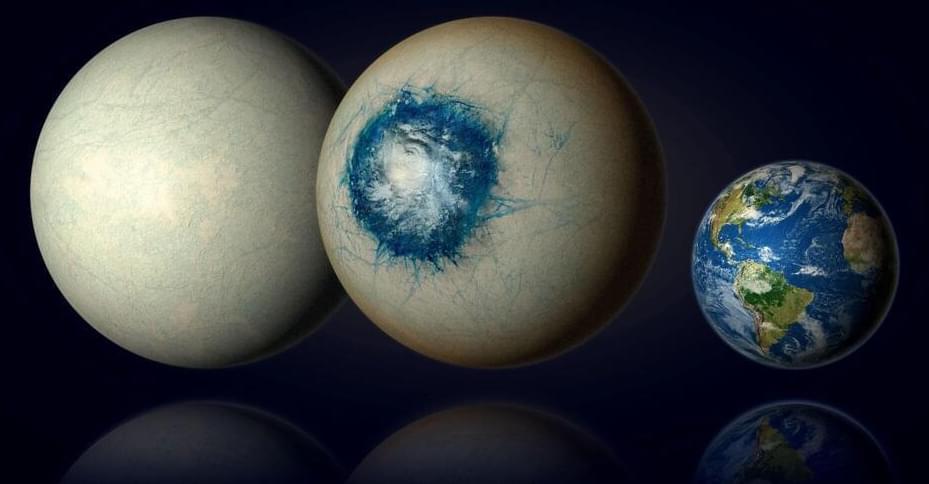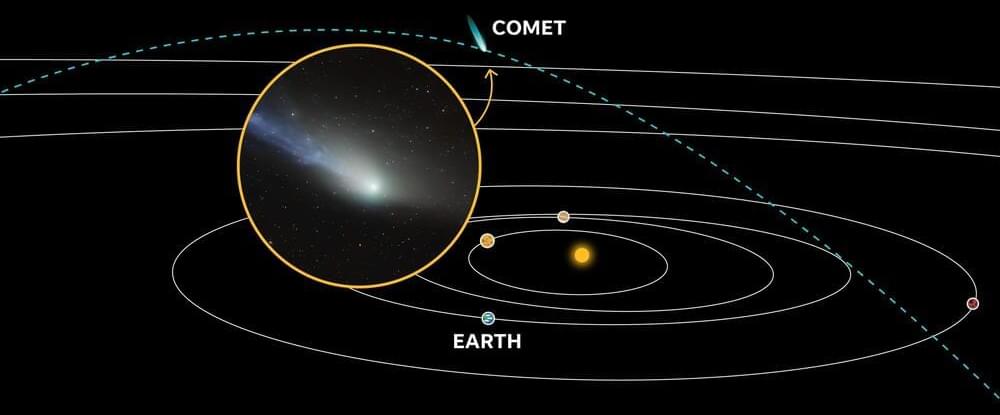Page 282
Jul 8, 2024
Astronomers find surprising ice world in the habitable zone with JWST data
Posted by Genevieve Klien in category: space
A team of astronomers has identified a temperate exoplanet as a promising super-Earth ice or water world.
The findings, led by Université de Montréal, show that the habitable zone exoplanet, LHS 1,140 b, is not likely a mini-Neptune, a small so-called gas giant—large planets composed mostly of gas—with a thick hydrogen-rich atmosphere. The planet, located about 48 light-years away in the constellation Cetus, emerges as one of the most promising habitable zone exoplanet candidates known, potentially harboring an atmosphere and even a liquid water ocean.
Data from the James Webb Space Telescope (JWST) were collected in December 2023 and added to previous data from other space telescopes Spitzer, Hubble, and TESS to solidify this result, accepted for publication in The Astrophysical Journal Letters this week and currently available on the arXiv preprint server.
Jul 8, 2024
9000-year-old ‘Stonehenge-like’ structure discovered at the bottom of Lake Michigan
Posted by Genevieve Klien in category: climatology
Dr. Mark Holley, a distinguished underwater archaeology professor at Northwestern Michigan University, recently unearthed a prehistoric structure in the bay that has drawn comparisons to England’s iconic Stonehenge. Located approximately 40 feet beneath Lake Michigan’s surface, this remarkable find is poised to transform our understanding of the region’s ancient history.
The submerged stones, although smaller than those at Stonehenge, appear to be meticulously arranged. These stones, varying in size from basketballs to compact cars, form a meandering line over a mile long. Among them, a particularly notable rock stands out. It measures three and a half to four feet tall and five feet wide, and features a carving of a mastodon—a testament to an era when these majestic creatures roamed the Earth.
The stones are estimated to be around 9,000 years old, predating Stonehenge by about 4,000 years. This period follows the end of the Ice Age and the formation of Grand Traverse Bay, when the lake bed had not yet been submerged.
Jul 8, 2024
Princeton Scientists Develop Passive Mechanism To Cool Buildings in the Summer and Warm Them in the Winter
Posted by Genevieve Klien in categories: energy, sustainability
Researchers have devised a passive thermal regulation mechanism using common materials that selectively manage radiant heat, providing a sustainable way to significantly improve building energy efficiency and comfort.
Engineers at Princeton and UCLA have developed a passive mechanism to cool buildings in the summer and warm them in the winter.
In an article recently published in the journal Cell Reports Physical Science, they report that by restricting radiant heat flows between buildings and their environment to specific wavelengths, coatings engineered from common materials can achieve energy savings and thermal comfort that goes beyond what traditional building envelopes can achieve.
Jul 8, 2024
See A Total Eclipse Of A Star As ‘Manhattanhenge’ Returns: The Night Sky This Week
Posted by Genevieve Klien in category: futurism
Each Monday, I pick out North America’s celestial highlights for the week ahead (which also apply to mid-northern latitudes in the northern hemisphere).
Jul 8, 2024
Comet 13P/Olbers streaks across July sky: How skywatchers can view
Posted by Genevieve Klien in category: space
The night sky has a visiting comet flaunting its faint tail for stargazers this summer.
The comet 13P/Olbers will make its closest approach to Earth later this month, according to NASA’s Jet Propulsion Laboratory.
The comet orbits the sun every 25,400 days. That’s about every 70 years – 69.54 to be exact. It was last be seen from Earth in 1956.
Jul 8, 2024
Researchers realize time reversal through input-output indefiniteness
Posted by Genevieve Klien in categories: evolution, information science, quantum physics
A research team has constructed a coherent superposition of quantum evolution with two opposite directions in a photonic system and confirmed its advantage in characterizing input-output indefiniteness. The study was published in Physical Review Letters.
The notion that time flows inexorably from the past to the future is deeply rooted in people’s mind. However, the laws of physics that govern the motion of objects in the microscopic world do not deliberately distinguish the direction of time.
To be more specific, the basic equations of motion of both classical and quantum mechanics are reversible, and changing the direction of the time coordinate system of a dynamical process (possibly along with the direction of some other parameters) still constitutes a valid evolution process.
Jul 8, 2024
The Wrong Objections to the Many-Worlds Interpretation of Quantum Mechanics
Posted by Dan Breeden in category: quantum physics
Longtime readers know that I’ve made a bit of an effort to help people understand, and perhaps even grow to respect, the Everett or Many-Worlds Interpretation of Quantum Mechanics (MWI). I’ve even written papers about it. It’s a controversial idea and far from firmly established, but it’s a serious one, and deserves serious discussion.
Jul 8, 2024
Revolutionizing Energy: Tesla’s Megapack Production Every 60 Minutes
Posted by Chris Smedley in categories: energy, sustainability

Tesla’s Megapack, with its ability to store and supply large amounts of renewable energy, has the potential to revolutionize the energy industry and contribute to a more sustainable future.
Questions to inspire discussion.
Continue reading “Revolutionizing Energy: Tesla’s Megapack Production Every 60 Minutes” »

















